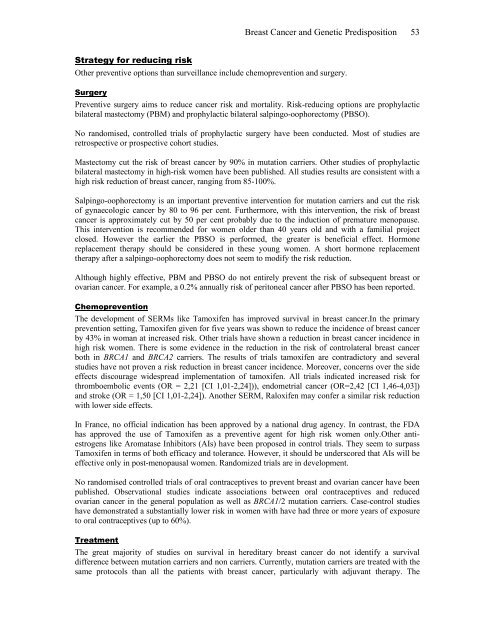Breast Cancer - Arab Medical Association Against Cancer
Breast Cancer - Arab Medical Association Against Cancer
Breast Cancer - Arab Medical Association Against Cancer
- No tags were found...
You also want an ePaper? Increase the reach of your titles
YUMPU automatically turns print PDFs into web optimized ePapers that Google loves.
<strong>Breast</strong> <strong>Cancer</strong> and Genetic Predisposition 53Strategy for reducing riskOther preventive options than surveillance include chemoprevention and surgery.SurgeryPreventive surgery aims to reduce cancer risk and mortality. Risk-reducing options are prophylacticbilateral mastectomy (PBM) and prophylactic bilateral salpingo-oophorectomy (PBSO).No randomised, controlled trials of prophylactic surgery have been conducted. Most of studies areretrospective or prospective cohort studies.Mastectomy cut the risk of breast cancer by 90% in mutation carriers. Other studies of prophylacticbilateral mastectomy in high-risk women have been published. All studies results are consistent with ahigh risk reduction of breast cancer, ranging from 85-100%.Salpingo-oophorectomy is an important preventive intervention for mutation carriers and cut the riskof gynaecologic cancer by 80 to 96 per cent. Furthermore, with this intervention, the risk of breastcancer is approximately cut by 50 per cent probably due to the induction of premature menopause.This intervention is recommended for women older than 40 years old and with a familial projectclosed. However the earlier the PBSO is performed, the greater is beneficial effect. Hormonereplacement therapy should be considered in these young women. A short hormone replacementtherapy after a salpingo-oophorectomy does not seem to modify the risk reduction.Although highly effective, PBM and PBSO do not entirely prevent the risk of subsequent breast orovarian cancer. For example, a 0.2% annually risk of peritoneal cancer after PBSO has been reported.ChemopreventionThe development of SERMs like Tamoxifen has improved survival in breast cancer.In the primaryprevention setting, Tamoxifen given for five years was shown to reduce the incidence of breast cancerby 43% in woman at increased risk. Other trials have shown a reduction in breast cancer incidence inhigh risk women. There is some evidence in the reduction in the risk of controlateral breast cancerboth in BRCA1 and BRCA2 carriers. The results of trials tamoxifen are contradictory and severalstudies have not proven a risk reduction in breast cancer incidence. Moreover, concerns over the sideeffects discourage widespread implementation of tamoxifen. All trials indicated increased risk forthromboembolic events (OR = 2,21 [CI 1,01-2,24])), endometrial cancer (OR=2,42 [CI 1,46-4,03])and stroke (OR = 1,50 [CI 1,01-2,24]). Another SERM, Raloxifen may confer a similar risk reductionwith lower side effects.In France, no official indication has been approved by a national drug agency. In contrast, the FDAhas approved the use of Tamoxifen as a preventive agent for high risk women only.Other antiestrogenslike Aromatase Inhibitors (AIs) have been proposed in control trials. They seem to surpassTamoxifen in terms of both efficacy and tolerance. However, it should be underscored that AIs will beeffective only in post-menopausal women. Randomized trials are in development.No randomised controlled trials of oral contraceptives to prevent breast and ovarian cancer have beenpublished. Observational studies indicate associations between oral contraceptives and reducedovarian cancer in the general population as well as BRCA1/2 mutation carriers. Case-control studieshave demonstrated a substantially lower risk in women with have had three or more years of exposureto oral contraceptives (up to 60%).TreatmentThe great majority of studies on survival in hereditary breast cancer do not identify a survivaldifference between mutation carriers and non carriers. Currently, mutation carriers are treated with thesame protocols than all the patients with breast cancer, particularly with adjuvant therapy. The









